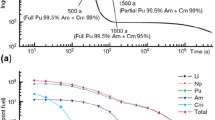Abstract
Natural short-lived radionuclides generate electronic defects in minerals, such as trapped electrons and positive holes, often associated with element impurities, which act as final traps over geological periods. Two main examples will be illustrated. The first example will concern the point defects, which are observed in clay minerals. The high specific surface area makes clay minerals sensitive to the geochemical radiation background and provides a record of the past occurrence of radionuclides in geological systems. In kaolinite, three types of hole-centers are trapped by oxygen atoms linked to Si- or Al-sites. An experimental dosimetry gives the paleodose, which can be used either to assess mean past U-concentration or for kaolinite dating, depending on the available geochemical parameters. The detection of past migrations of radioelements in natural analogues may be used in the safety assessment of radioactive waste disposals. The second example will concern the role of mineral impurities in defect formation and stabilization. Natural fluorites (CaF2) exhibit hole-and electron-centers trapped on several rare earths and oxygen impurities, often present at the ppm level, which are responsible for the wide range of coloration observed in natural fluorites. Ca colloids may form under severe irradiation and give rise to a characteristic absorption. The thermal stability of radiation-induced defects gives constraints on the evolution of fluorites as a function of temperature and time. Other minerals, such as apatite, confirm the importance of impurities in stabilizing radiation- induced defects over geological periods.
Similar content being viewed by others
References
M. Ikeya, New applications of electron spin resonance. Dating, Dosimetry and Microscopy. (World Scientific, 1993).
A.S. Marfunin. Spectroscopy, Luminescence and Radiation Centers in Minerals (Speringre Verlag, 1979).
J. P. Muller, B. Clozel, Ph. Ildefonse and G. Calas Appl. Geochem. 1, 205–216 (1992); I.A. Sobolev, A.S. Barinov, L.M. Khomchik, M.I. Ozhovan, E.M. Timofeev Soviet Atomic Energy. 59, 697–698 (1985).
G. Calas in Spectroscopic Methods in Mineralogy and Geology, edited by F. Hawthorne (Rev. Miner. 18, 1988) pp. 513–571.
G. Morin and D. Bonnin J. Magn. Res. 136, 176 (1999).
J. P. Muller and G. Calas Econ. Geol. 84, 694 (1989); J.P. Muller, Ph. Ildefonse and G. Calas Clays Clay Miner. 38, 600 (1990)
B. Clozel, T. Allard and J.P. Muller Clays Clay Miner. 42 657 (1994).
B. Clozel, J.M. Gaite and J-P. Muller. Phys Chem. Miner. 22, 351 (1995).
T. Allard, J.P. Muller, J.C. Dran and M.T. Menager Phys. Chem. Miner. 21, 85 (1994).
T. Allard and J.P. Muller Appl. Geochem. 13, 751 (1998).
Ph. Ildefonse, J.P. Muller, B. Clozel and G. Calas Eng. Geol. 29, 413 (1990).
E. Balan, T. Allard, B. Boizot, G. Morin and J.P. Muller Clays Clay Miner 47, 605 (1999); E. Balan, T. Allard, B. Boizot, G. Morin and J.P. Muller Clays Clay Miner 48, 439 (2000).
E. Balan, T. Allard, E. Fritsch, M. Sélo, C. Falguères, F. Chabaux, M.C. Pierret and G. Calas Geochim. Cosmochim. Acta, submitted.
T. Allard, Ph. Ildefonse, L. Perez del Villar, S. Sorieul, M. Pelayo, B. Boizot, E. Balan and G. Calas Eur. J. Miner. 15, 629 (2003).
S. Sorieul, T. Allard, B. Boizot and G. Calas Phys. Chem. Minerals, submitted.
D. Gournis, A.E. Mantaka-Marketou, M.A. Karakassides and D. Petridis Phys. Chem. Minerals 27, 514 (2000).
H. Bill and G. Calas Phys. Chem. Minerals 3, 117 (1978).
G. Calas Bull. Soc. Franc. Minéral. Crist. 95, 470 (1972).
G. Calas, H. Curien, Y. Farge and R. Maury C.R. Acad. Sci. (Paris) 274, 781 (1972).
G. Calas and J.C. Touray Modern Geol. 3, 209 (1972).
G. Morin, T. Allard, E. Balan, Ph. Ildefonse and G. Calas Eur. J. Mineral. 14, 1087 (2002).
Acknowledgments
We thank Prof. L Wang for inviting us at the 2003 MRS Fall Meeting and providing a careful review of the manuscript. Most studies reviewed in this paper were supported by the Commissariat à l'Energie Atomique (CEA, France) and the CNRs/iNSU PROSE and PNSE programs. One of us (S.S.) acknowledges a doctoral fellowship from the Agence de Stockage des Déchets Radioactifs (ANDRA, France). This is IPGP contribution #1964.
Author information
Authors and Affiliations
Rights and permissions
About this article
Cite this article
Calas, G., Allard, T., Balan, E. et al. Radiation-induced Defects in Nonradioactive Natural Minerals: Mineralogical and Environmental Significance. MRS Online Proceedings Library 792, 22–33 (2003). https://doi.org/10.1557/PROC-792-R2.6
Published:
Issue Date:
DOI: https://doi.org/10.1557/PROC-792-R2.6




